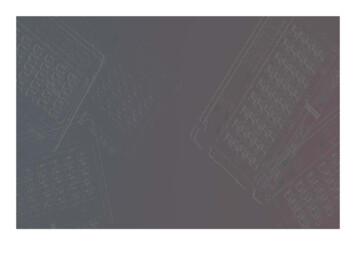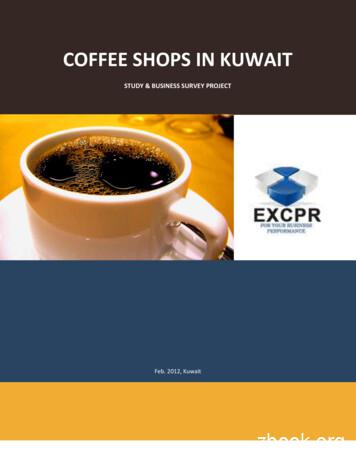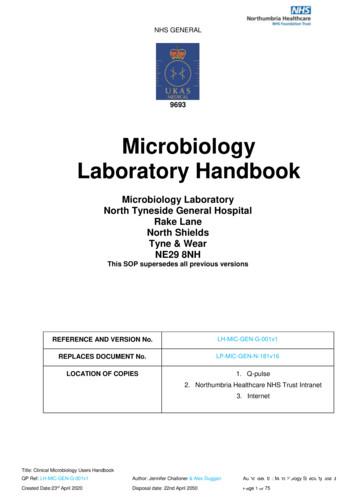Clinical Microbiology Kuwait Board Curriculum & General .
Clinical Microbiology Kuwait BoardCurriculum & General Objectives2014The educational program provides:1. A broad understanding of the diagnosis and management of infectious diseasefrom a clinical and laboratory perspective2. The diagnostic techniques required in the practice of clinical microbiology3. understanding of the areas of clinical microbiology detailed in the curriculum4. knowledge of specialist areas for medical microbiology infection control,virology, mycology, parasitology and public health5. The communication skills required for the practice of clinical microbiology andthe teaching skills necessary for effective practice6. The acquisition of management skills required in the running of themicrobiology laboratory7. knowledge of the health protection aspects of clinical microbiology8. Experience of research and development projects and critical assessment ofpublished work so as to contribute in a team and individually to thedevelopment of the service.1
9. The acquisition of life-long habits of reading, literature searches, consultationwith colleagues, attendance at scientific meetings, and the presentation ofscientific work that are essential for continuing professional development(CPD)10.Experience of the practice of clinical governance and audit (specialist andmultidisciplinary) through evaluation of practice against the standards ofevidence-based medicine, which underpin medical microbiology practice.The balance between practical laboratory and clinical training will beinfluenced by educational background, personal interests and guidance fromsupervisors.2
PGY1 (R1)The trainee has a comprehensive understanding of the principles and practicesof medical microbiology under direct supervision.PGY1 (R1) training:1. It is a 12 months full-time.2. This stage of the curriculum will begin with a formal introduction to the basicprinciples of medical microbiology and virology.3. Following the induction period, the trainee will receive instruction and practicalexperience in further aspects of medical microbiology and virology.4. The PGY1 (R1) training will be assessed by Rotation Supervisors and Programdirector.PGY2 (R2) training:The trainee has a good general knowledge and understanding of most principles andpractices under indirect supervision.3
They should be able to deal with most of the day-to-day issues in a hospitalmicrobiology laboratory to an adequate level but will still require consultant inputwith.PGY2 (R2) training is between months 13 –to- 24.During PGY2 (R2) training, the trainee will continue to broaden their experience andunderstanding of medical microbiology.The knowledge gained during this stage of training will be assessed by the CMKBPart 1 examination.In order to complete PGY2 (R2) of medical microbiology training, trainees musthave:1. Satisfactorily completed a total of at least 12 months of training.2. Achieved satisfactory outcomes in the requisite number of workplace-basedassessments3. Obtained one or more satisfactory outcomes in the ARCP to indicatesatisfactory progress in training.4
PGY3 (R3) training:PGY3 (R3) training is between months 24-36.This stage of the curriculum enables the trainee to undertake further specializedgeneral medical microbiology training.In order to complete PGY3 (R3) of medical microbiology training, trainees musthave:1. Satisfactorily completed a total of at least 36 months of training of which atleast 12 months should be in PGY3 (R3)2. Achieved satisfactory outcomes in the requisite number of workplace-basedassessments3. Passed the CMKB Part 1 examination in medical microbiology4. Obtained one or more satisfactory outcomes in the ARCP to indicatesatisfactory progress in training.5
PGY4 (R4) training:PGY4 (R4) training is between months 36 -48.This stage of the curriculum prepares the trainee for their senior post.The ARCP undertaken at the end of PGY3 (R3) should identify goals for the trainee toachieve during this year of training.The trainee has an in-depth knowledge and understanding of the principles of medicalmicrobiology.They should be competent to discuss and deal with the subject (or, where appropriate,perform the task/procedure), demonstrating a level of clinical or professionaljudgment commensurate with independent professional practice at senior level.It is anticipated that a trainee at this level should have senior input readily available atall times where required.By the end PGY4 (R4), the trainee should be able to demonstrate a level of knowledgeand skill indicating suitability for independent professional practice in medicalmicrobiology.6
In order to complete PGY4 (R4) of medical microbiology training, trainees musthave:1. Satisfactorily completed a total of at least 48 months of training. of which atleast 12 months should be in PGY4 (R4)2. Achieved satisfactory outcomes in the requisite number of medicalmicrobiology workplace-based assessments3. Satisfactorily completed all areas of the medical microbiology curriculum4. Obtained one or more satisfactory outcomes in the ARCP to indicatesatisfactory progress in training.PGY5 (R5) training:PGY5 (R5) training is between months 48-60.This stage of the curriculum prepares the trainee for their consultant post.The ARCP undertaken at the end of PGY4 (R4) should identify goals for the trainee toachieve during their final year of training.The trainee has an in-depth knowledge and understanding of the principles of medicalmicrobiology.7
They should be competent to discuss and deal with the subject (or, where appropriate,perform the task/procedure), demonstrating a level of clinical or professionaljudgment commensurate with independent professional practice at consultant level.It is anticipated that a trainee at this level should have consultant input readilyavailable at all times where required.By the end PGY5 (R5), the trainee should be able to demonstrate a level of knowledgeand skill indicating suitability for independent professional practice in medicalmicrobiology.The knowledge and skill gained during this stage of training will be assessed by theCMKB Final examination.In order to complete PGY5 (R5) of medical microbiology training, trainees musthave:1. Satisfactorily completed a total of at least 60 months of training. of which atleast 12 months should be in PGY5 (R5)2. Achieved satisfactory outcomes in the requisite number of medicalmicrobiology workplace-based assessments3. Satisfactorily completed all areas of the medical microbiology curriculum8
4. Obtained an ARCP outcome 6 to indicate that all clinical (and research whererelevant) competences have been achievedCONTENT OF LEARNINGA.Core medical microbiology curriculum1. Laboratory aspects of microbiology2. Knowledge of health and safety3. Clinical skills, including the diagnosis and management of:a. infection in the communityb. healthcare-associated infection, including hospital-acquired infection andpreventionc. infection in immunocompromised patients including human immunodeficiencyvirus (HIV), transplantation and neutropeniad. infection in the Intensive Care Unit (ICU) and Special Care Baby Unit (SCBU),including sepsise. outbreaks of infection in hospital and the communityf. infection in the returning travelerg. sexually transmitted infectionh. food- and water-borne infectioni. pediatric infectionj. Infection in pregnancy.9
4. Specialist areas of MicrobiologyThe trainee will acquire a working knowledge; with the opportunity to sub specializeif required, in:a. Virologyb. Health protection and epidemiologyc. Mycologyd. Parasitology.5. Communication and management issues in microbiologyDeveloping independent practice:The trainee will develop the clinical, scientific, technical, management,communication and leadership skills required to run a laboratory and deliver a highquality clinical service.Workplace-based assessment:Trainees will be expected to undertake workplace-based assessment throughout theentire duration of their training in medical microbiology.These will comprise:1. Case-based discussion (CbD) (minimum of 6 satisfactory outcomes required peryear)2. Directly observed practical skills (DOPS) (minimum of 6 satisfactory outcomesrequired per year for years R1 and R2; minimum of 4 satisfactory outcomesrequired per year for years R3, R4 and R5)3. Evaluation of Clinical/Management Events (ECE) (minimum of 4 satisfactoryoutcomes required per year for years R1 and R2; minimum of 6 satisfactoryoutcomes required per year for years R3, R4 and R5)SUPERVISION AND FEEDBACK10
The role of the educational supervisor is to:1. have overall educational and supervisory responsibility for the trainee in a givenpost2. ensure that the trainee is familiar with the curriculum relevant to the year/stageof training of the post3. ensure that the trainee has appropriate day-to-day supervision appropriate totheir stage of training4. ensure that the trainee is making the necessary clinical and educational progressduring the post5. ensure that the trainee is aware of the assessment system and undertakes itaccording to requirements6. act as a mentor to the trainee and help with both professional and personaldevelopment7. agree a training plan (formal educational contract) with the trainee and ensurethat an induction (where appropriate) has been carried out soon after thetrainee’s appointment8. discuss the trainee’s progress with each trainer with whom a trainee spends aperiod of training9. undertake regular formative/supportive appraisals with the trainee (at least twoper year, approximately every six months) and ensure that both parties agree tothe outcome of these sessions and keep a written record10.regularly inspect the trainee’s training record, inform trainees of their progressand encourage trainees to discuss any deficiencies in the training program,ensuring that records of such discussions are kept11.keep the program director informed of any significant problems that may affectthe trainee’s trainingIn order to become an educational supervisor, a consultant must have a demonstratedinterest in teaching and training, appropriate access to teaching resources, be involvedin and liaise with the PGTC committee, be involved in annual reviews and liaiseclosely with KIMS Program Director.11
SPECIALTY-SPECIFIC MEDICAL MICROBIOLOGY CURRICULUM PGY1(R1)INTRODUCTIONFor many trainees, this period of training represents their first exposure to laboratorymedicine (microbiology).During this period there will be training in microbiology.A formal period of instruction under supervision takes place at the beginning of thisblock and aims to provide an introduction to laboratory infection.This introductory period will last approximately three to four months and isdesigned to equip the trainee with the fundamental knowledge and skills for thepractice of medical microbiology, including necessary virology.Knowledge will also be acquired through self-directed learning and formal lectures.Skills will be acquired through a formal training program supervised by educationalsupervisors.The curriculum for this stage is divided into two sections:1. Fundamental skills2. Core knowledge.Fundamental skills are essential to the practice of laboratory medicine (microbiology)and provide the foundation on which to develop.1. FUNDAMENTAL SKILLSObjective: To acquire sufficient knowledge of laboratory techniques to underpinclinical practice.By the end of PGY1 (R1), and before proceeding to PGY2 (R2)of training, the traineeshould:a. have gained a thorough understanding of laboratory health and safetypracticeb. have gained experience in the safe handling of clinical samples in thelaboratoryc. have gained a basic understanding of quality assurance in the diagnosticlaboratoryd. have developed, under supervision, core reporting skillse. have sufficient understanding of microbiology, mycology, immunology,virology and parasitology to offer basic advice on the interpretation oflaboratory results12
f. be able to manage common medical emergencies relevant to their clinicalpracticeg. Understand the importance of infectious disease notifications.h. function as part of a multidisciplinary teami. recognize critical incidents and start to understand how to manage themj. understand the importance of clinical audit and risk management2. CORE KNOWLEDGEObjective:To achieve sufficient understanding of laboratory microbiology to offer basic adviceon relevant investigations, infection control procedures and interpretation of results.Subject:1- Basic biology relevant to microorganisms and infectiona. Explain basic biology (structure, genetics, taxonomy, epidemiology) of majorbacterial, viral, fungal and parasitic agentsb. Explain basics of the immune response to infectionc. Compare and contrast cellular and humoral immunityd. Explain the basis of how vaccines worke. Explain the basics of molecular biologyf. Explain the basis of genetic susceptibility to pathogens and disease2- Host pathogen relationshipsa. Explain the basis of how the immune response protects against infection,and how it may contribute to pathogenesis of infectious diseasesb. Explain the basis of different types of host parasite relationships, e.g.symbiosis, viral latency, etc.c. Explain the types of immunodeficiency and how they affect susceptibilityto and control of infectious diseasesd. Explain pathogenic mechanisms involved in infectious diseases and therole of host response in immunopathology3- Laboratory safetya. Explain basic laboratory hazards and precautions against them13
4- Classification of pathogensa. Explain principles of standard precautions, hazard groups and containmentlevels5- Standards of practicea. Describe the importance and relevance of standards to good laboratorypractice.b. Understand the evidence base behind standard operating procedures(SOPs)/examination procedures (EPs) and the importance of audit andquality control to establish validity6- Basic principles of diagnostic microbiologya. Explain the range of tests available, and the circumstances in which they areusedb. Explain the difference between sterile and contaminated/colonized body sitesc. Explain basic techniques for serodiagnosis in infectious diseasesd. Explain nucleic acid-based detection system such as polymerase chain reaction(PCR)e. Explain simple antimicrobial and antiviral susceptibility testing and itsinterpretationf. Explain the basic principles behind drug monitoring and its uses14
7- Clinical syndromes – advice and managementOutline the principles of epidemiology, presentation, diagnosis and management ofclinical syndromes:a. genitourinary tract infection including sexually transmitted infections(STIs) and bacterial urinary tract infectionb. respiratory tract infectionc. gastrointestinal infectionsd. skin and soft tissue infectione. eye infectionf. post-operative infectiong. inoculation incidenth. encephalitis/meningitisi. brain abscessj. hepatitis including test interpretationk. rashes and rash contacts (pregnant and non pregnant)l. infections in pregnancy, including methods of diagnosis, and implicationsof infection for mother and fetusm. congenital infection and infection acquired perinatallyn. infections in the immunocompromised including basico. understanding of how to make the diagnosis of infection and treatmentoptionsp. deep infection (e.g. septicaemia, endocarditis, bone infection)q. common nosocomial infection (e.g. device-associated infection)r. infection in travelers (e.g. malaria)s. community-acquired and nosocomial infections in which environmentalfactors play a role (e.g., food, water, air)8- Treatment and prevention strategiesa.b.c.d.e.f.Explain therange of therapies available for infectious disease, the clinicalindications for their use and their side effectsExplain the classification of antimicrobial agentsExplain in detail the mechanism of action of acyclovir and beta-lactam antibioticagents and mechanisms for development of resistance to these agentsExplain the basic principles of action and resistance for other antimicrobialagents, their uses and limitationsExplain the basic principles of prophylaxis, both with antimicrobials and withimmune globulinsDescribe existing vaccines and the schedules of immunization.15
9- Infection prevention and controla. Describe routes of transmission and methods of preventing nosocomial spreadof common and important infecting organisms (‘alert organisms’), including:1. methicillin-resistant and -sensitive Staphylococcus aureus2. vancomycin-resistant enterococci3. varicella zoster virus4. Enteric infections including viral diarrhea5. respiratory tract infections, including TB6. Blood-borne viruses7. extended-spectrum beta-lactamase-producing organisms (ESBLs)8. Multiply-resistant Acinetobacter baumanii9. Clostridium difficile associated diarrhoeab. Describe issues surrounding the isolation of the febrile travelerc. Describe the principles and practice of surveillance and public health withparticular regard to food-borne and vaccine preventable infections and STIs10- Sterilization and disinfectiona. Describe basic termsb. Describe the basis of the different methods availablec. Describe the importance of removal of pathogenic organisms in the preventionof infection in:1. pre-operative sterilization2. aseptic technique3. decontamination of environmental sources16
SPECIALTY-SPECIFIC MEDICAL MICROBIOLOGY CURRICULUMPGY2-5 (R2-R5)INTRODUCTIONThis period of training in medical microbiology will consist of consolidation ofclinical and laboratory work started in PGY1 (R1) up to consultant level.Flexibility at this stage will be encouraged to reflect the needs of the trainee and mayadditionally include modules such as virology, epidemiology, public health medicine,research, time in another laboratory, etc.1. LABORATORY ASPECTS OF MICROBIOLOGYObjective: to be competent in the management of the microbiology laboratory.A. Understanding of appropriate staining and culture techniquesDescribe microscopy, culture and identification techniques for commonpathogensProcess all routine specimens received in the laboratory and carry out furthertests necessary for full identification of pathogensB. Antimicrobial susceptibility testingDescribe current techniques for susceptibility testing including Etest, brothdilution and automated methodologies with appropriate quality controlPerform simple susceptibility testsProvide clinical advice based on interpretation of the results of susceptibilitytestingAnalyze use and limitations of the antibiogram for outbreak investigation andcontrolC. Understand serologic and antigen-based techniquesDescribe the basis and clinical interpretation of results of latex agglutination,enzyme-linked immunosorbent assay (ELISA), immunofluorescence,complement fixation test (CFT) and the various controlsPerform simple serological tests Provide clinical advice based on interpretationof the results of serology17
B. Molecular diagnostic techniques Describe the principles and applications of serological and nucleic acidbased techniques relevant to Microbiology Describe the criteria for selection of tests and their interpretation indisease diagnosis, appropriate therapy and follow-up, includingadvantages and limitations Provide clinical advice based on the interpretation of results ofserological and nucleic acid-based techniquesC. Knowledge of automated and semi-automated methodologies inmicrobiologyDescribe automated culture and identification methodologiesD. Point-of-care testingDescribe the role of clinical governance issues with and quality assurance ofpoint of-care testing.E. Knowledge of typing methods availableExplain the principles, advantages and limitations of various phenotypic andgenotypic methodsDescribe the role of typing in incident/outbreak investigationsRecommend appropriate typing methods for clinical situations and interpret theresultsF. Reference centersDescribe the indications for referral of specimens to referen
Clinical Microbiology Kuwait Board Curriculum & General Objectives 2014 The educational program provides: 1. A broad understanding of the diagnosis and management of infectious disease from a clinical and laboratory perspective 2. The diagnostic techniques required in the practice of clinical microbiology 3. understanding of the areas of clinical microbiology detailed in the curriculum 4 .
Schlumberger, Kuwait City, Kuwait (myaser@slb.com) 2. Kuwait Oil Company, Kuwait City, Kuwait . . standardized and auditable log processing and normalization procedures were prepared to facilitate the petrophysical interpretation. . using historical charts Porosity calculated at each vintage well was
ISO 22000 Manual KM 01 Quality System ISO 22000: 2005 Issue Date 01-11-2010 Total Pages Copy Number Kuwait International Airport, P.O. Box 24417, Kuwait City Safat 13105 Kuwait Phone No. ðà 965 2434-5555, 2434-6666 Fax No. ðà 965 2431-5632 E mail ðàinfo@kasco.com.kw Websiteðàwww.kasco.com.kw
An Introduction to Clinical Microbiology Susan M. Poutanen, MD, MPH, FRCPC . Objectives 1. To provide an introduction to a typical microbiology laboratory 2. To address specific microbiology laboratory test issues as they apply to public health. Department of Microbiology Who we are Shared microbiology service between TML (UHN & MDS) and MSH
What is Clinical Microbiology? Function of the clinical microbiology laboratory: Clinical: diagnosis and management of infections Epidemiological: understand infectious microbes in patients and populations, and to find sources and routes of transmission necessary for prevention efforts General rules in clinical microbiology: #1:
Industrial microbiology Medical and pharmaceutical microbiology Rumen microbiology Space microbiology 1.2 Definitions Milk and milk products occupy a more significant role in the human food profiles. The study of microorganisms that are associated with milk and milk products in all aspects is defined as "Dairy Microbiology". 1.2 .
COFFEE SHOPS IN KUWAIT STUDY & BUSINESS SURVEY PROJECT Feb. 2012, Kuwait . SUMMARY T his study is aiming to; Measure the coffee shop market . Market share for Starbucks Coffee shops 0 200 400 600 800 Efficency factor for COLUMBUS Cafe' P.O info@excpr.com www.excpr.com 965 600 excpr (39277) P.O. Box, 3378 Meshref 40283 Kuwait
Title: Clinical Microbiology Users Handbook QP Ref: LH-MIC-GEN-G-001v1 Author: Jennifer Challoner & Alex Duggan Authorised by: Microbiology Specialty board Created Date:23rd April 2020 Disposal date: 22nd April 2050 Page 1 of 75 9693 Microbiology Laboratory Handbook Microbiology Laboratory North Tyneside General Hospital Rake Lane North Shields Tyne & Wear NE29 8NH This SOP supersedes all .
least one letter and one number) that is used in conjunction with an account users’ Customer ID to access their account online securely. PIN The PIN is a six digit numeric code that is used to identify an account user when they try toaccess services throughthe call centre. It is used in conjunction with the Account Holder’s Account Number or Users’ Customer ID. Registered Vehicles Any .























